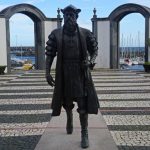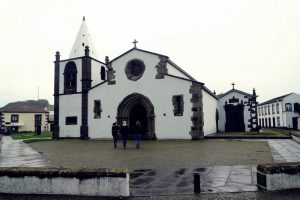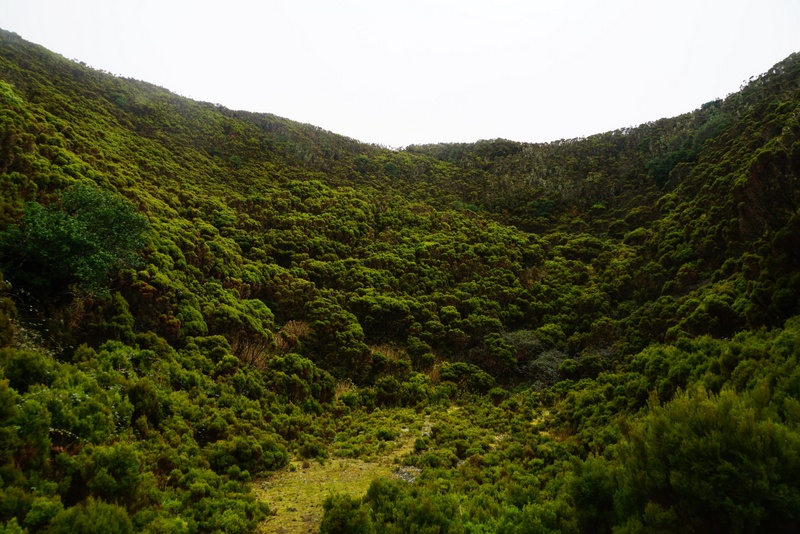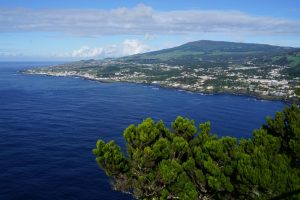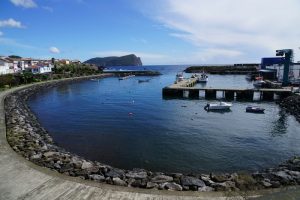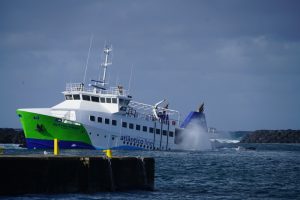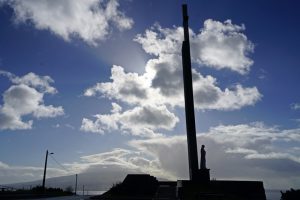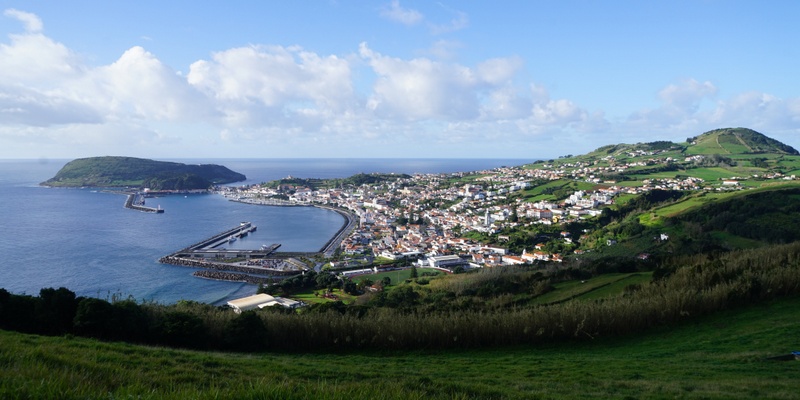Terceira, Pico, & Faial February 20 – 25
The Azores
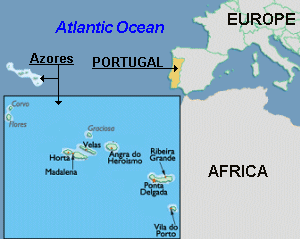 The Azores is an archipelago located about 1,360km west of continental Portugal and 1,925km southeast of Newfoundland, Canada above an active junction between three of the world’s largest tectonic plates (the North American Plate, the Eurasian Plate and the African Plate). It comprises nine volcanic islands in the North Atlantic Ocean (namely Corvo, Faial, Flores, Graciosa, Pico, Sao Jorge, Sao Miguel, Santa Maria and Terceira). The islands are divided into three groups: Corvo and Flores in the Western Group, Sao Miguel and Santa Maria the Eastern Group and the remaining five in the Central Group.
The Azores is an archipelago located about 1,360km west of continental Portugal and 1,925km southeast of Newfoundland, Canada above an active junction between three of the world’s largest tectonic plates (the North American Plate, the Eurasian Plate and the African Plate). It comprises nine volcanic islands in the North Atlantic Ocean (namely Corvo, Faial, Flores, Graciosa, Pico, Sao Jorge, Sao Miguel, Santa Maria and Terceira). The islands are divided into three groups: Corvo and Flores in the Western Group, Sao Miguel and Santa Maria the Eastern Group and the remaining five in the Central Group.
Like Madeira, the Azores is an Autonomous Region of Portugal with a population of about 250,000. The Azores has three capital cities namely Angra do Heroismo in Terceira, Horta in Faial and Ponta Delgada in Sao Miguel. The highest point is Mount Pico at 2,351m.
First appeared in the Atlas Catalan in the 14th century, Santa Maria of the Azores was the first island to be rediscovered in 1427 by the Portuguese sailors in the service of Henry the Navigator. Settlers began to arrive from mainland Portugal. Angra do Heroismo was the first town in the archipelago to be elevated to the status of city in 1534. The Azores was the last part of the Portuguese Empire to resist the Spanish King Philip II’s reign over Portugal (He became King of Portugal from 1581 to 1598) and the Iberian Union lasted till 1640 when the Azores was returned to Portuguese control.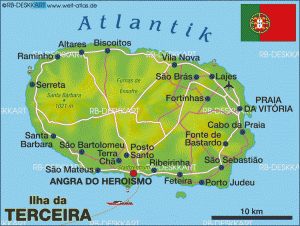
The nine islands have a total surface area of 2,346km2. Each island is unique with its distinct geomorphological characteristics. Today, the main industries are agriculture, dairy farming, livestock, fishing and tourism.
February 20 Tuesday: Madeira (GMT) – Terceira (GMT-1) by Air
I travelled to the Azores with SATA which deploys propeller small planes between the nine islands. I had to fly first to Ponta Delgada, Sao Miguel, the largest island of the archipelago and waited for a connecting flight to Terceira. I ended up travelling on the same plane to Terceira. The flight took only 25 minutes and I landed at the airport shortly after 2:30pm (local time). Bus service on the island is infrequent. I therefore had to take a taxi (20 euro) to My Angra Boutique Hostel on Rua de Sao Pedro in Angra do Heroismo (generally known as Angra). The hostel opened last May is the best I have stayed: clean, modern, stylish and comfortable. As it was low season, I paid for a bed (18 euro a night) in a 3-bedded room but ended up having a spacious room to myself for three nights.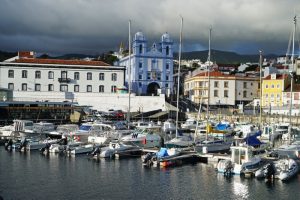
Angra has a population of about 35,000 (2011) and the central zone of the town and is a World Heritage Site. The town is full of history: it has been considered the Atlantic’s first European city founded and developed as a result of the opening up of new geographical and cultural horizons during the Age of Discoveries. The port had played an important role in the Portuguese East Indies trade that began in the 15th century.
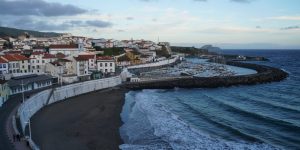 Mainland Portuguese began to settle in Angra after 1460. In 1534, it was given the status as a city. It played an important role for almost three centuries in the history of European expansion as it was one of the axes of the routes that crossed the oceans that facilitated the establishment of a global economy. Galleons laden with gold and silver from the Americas, spices and treasures from the Orient, anchored in the port. For defence purposes, the fortress of Sao Sebastiao and Sao Filipe/Sao Joao Baptista (one of the Atlantic’s biggest) were built, along with more than 40 forts along the coast of the island of Terceira. Angra has therefore been a meeting point of different cultures.
Mainland Portuguese began to settle in Angra after 1460. In 1534, it was given the status as a city. It played an important role for almost three centuries in the history of European expansion as it was one of the axes of the routes that crossed the oceans that facilitated the establishment of a global economy. Galleons laden with gold and silver from the Americas, spices and treasures from the Orient, anchored in the port. For defence purposes, the fortress of Sao Sebastiao and Sao Filipe/Sao Joao Baptista (one of the Atlantic’s biggest) were built, along with more than 40 forts along the coast of the island of Terceira. Angra has therefore been a meeting point of different cultures.
It has also been a popular place for out-of-flavour monarchs. It served as a place of exile for Almeida Garret during the Napoleonic War. Queen Maria II of Portugal stayed on the island from 1830 to 1833. Angra was hit by a major earthquake on January 1, 1980 and was rebuilt within four years.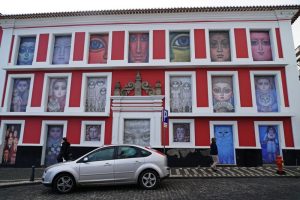
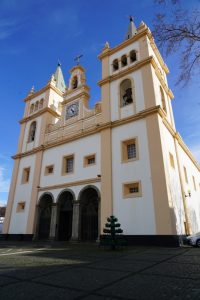 I spent the afternoon wandering aimlessly in the old town. I followed the main street Rua da Se and stopped at the Se Cathedral before reaching the main square, Praca Velha where the Town Hall stands. Then I turned to Rue Direita, which was the first main street from the wharf to Praca Velha. The narrow side streets with cobbled-stone roads and colourful town houses with different architectural styles are interesting.
I spent the afternoon wandering aimlessly in the old town. I followed the main street Rua da Se and stopped at the Se Cathedral before reaching the main square, Praca Velha where the Town Hall stands. Then I turned to Rue Direita, which was the first main street from the wharf to Praca Velha. The narrow side streets with cobbled-stone roads and colourful town houses with different architectural styles are interesting.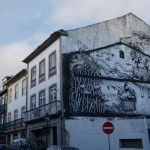
But I was not in a mood for sight-seeing as I had to sort out my itinerary. My original plan was island-hopping by ferry before reaching Pico on February 25. At the airport, I was told that there was no ferry service between Terceira and Sao Jorge and I had to leave the island by air. I was advised to go to a local travel agent in town to buy a ticket. At the first agent, I was told that a ticket for a foreigner would cost 180 euro. Unbelievable!
I immediately went to Vodafone and paid 10 euro for a SIM Card. I surfed and found a ticket to Pico on February 23 for less than 89 euro. I should have done more homework and bought the inter-island tickets with SATA as a package.
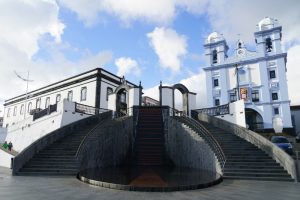 After securing a plane ticket, I was relieved and walked to the end of Rue Direita where the blue Igreja da Misericordia stands next to the port. It was already 5pm and the church was closed. I walked along the beach which was the former shipyard and tried to look for a restaurant. But the good ones open between 6:30 and 7pm. It’s late for me. I walked back to Rua de Sao Pedro and had dinner in Restaurant Elios. A big grill rock fish and a half a bottle of green wine cost me 16euro. I like my room and had an excellent sleep!
After securing a plane ticket, I was relieved and walked to the end of Rue Direita where the blue Igreja da Misericordia stands next to the port. It was already 5pm and the church was closed. I walked along the beach which was the former shipyard and tried to look for a restaurant. But the good ones open between 6:30 and 7pm. It’s late for me. I walked back to Rua de Sao Pedro and had dinner in Restaurant Elios. A big grill rock fish and a half a bottle of green wine cost me 16euro. I like my room and had an excellent sleep!
February 21 Wednesday: Full Day Round Island Excursion
On the recommendation of the hostel receptionist, I joined a full day excursion (60 euro including lunch). I was picked up by my guide who was born in the US and raised in the Azores. She prefers to live here while her two brothers have returned to live in the US. An American couple from Oregon was on the same tour.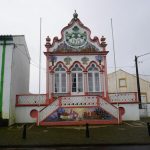
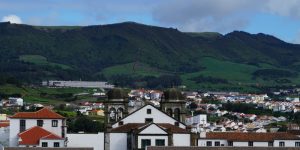 The weather was not good with a grey sky. We headed to Monte Brasil part of the World Heritage Site with an imposing Fortress of Sao Filipe built around 1592 by order of Philip II of Spain and I of Portugal and the Church of Sao Joao Baptista built in 1645.
The weather was not good with a grey sky. We headed to Monte Brasil part of the World Heritage Site with an imposing Fortress of Sao Filipe built around 1592 by order of Philip II of Spain and I of Portugal and the Church of Sao Joao Baptista built in 1645.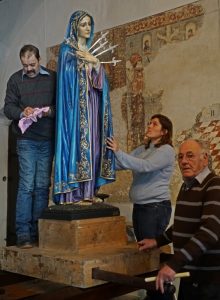
Our first stop was to look at the caldera before going to Pico Cruzinhas (the highest point at 205m) where the monumental cross was built to mark Portuguese occupation of the Azores during the Age of Discoveries.
Then we drove heading to Praia da Vitoria with several stops to look at the two islets, Porto Judeu, the oldest church on the island at Sao Sebastiao and natural swimming pools at Porto Martins. Along the way, we saw many colourful shrines dedicated to the Holy Spirit (Imperios). We were also driven to see the American air base which has made substantial contribution to the economy of the island. The American has been downsizing to about 300. America’s plan on the island is not clear (Perhaps with President Trump, no one is clear what America wants to do!)
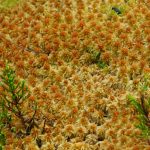
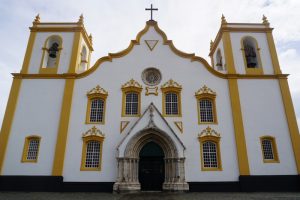 We had 20 minutes’ free time in Praia da Vitoria before going to Sabores do Chef for lunch. The restaurant is modern and chic. I had a sumptuous 3-course lunch. The ‘alcatra’ with beef slowly cooked in a clay pot in the oven is most delicious and filling. I was full after having a few pieces of meat.
We had 20 minutes’ free time in Praia da Vitoria before going to Sabores do Chef for lunch. The restaurant is modern and chic. I had a sumptuous 3-course lunch. The ‘alcatra’ with beef slowly cooked in a clay pot in the oven is most delicious and filling. I was full after having a few pieces of meat.
In the afternoon, we drove through the central wooded part of the island to reach Furnas do Enxofre with numerous fumaroles.
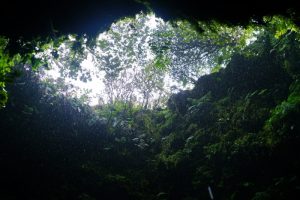
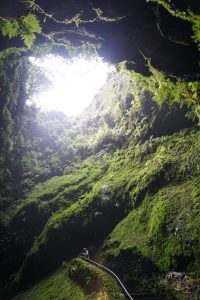 The highlight of the day was Algar do Carvao, an extinct volcano where one can go inside. Cool and unique! We descended into the volcano through a tunnel and staircases. It is awesome to see the volcanic chimney and secondary magma chambers inside a volcano. The first eruption took place some 3,200 years ago and the second eruption in the same place happened a thousand years later. At the bottom is a small lake. It is a most wonderful experience as there are few places on earth one can walk into a volcano which now looks like a wonderland with lush vegetation, chambers, unique stalactites and stalagmites. The other place one can go into a volcano is Iceland (I paid for this trip in Iceland last September but could not go when my passport was stolen in Madrid).
The highlight of the day was Algar do Carvao, an extinct volcano where one can go inside. Cool and unique! We descended into the volcano through a tunnel and staircases. It is awesome to see the volcanic chimney and secondary magma chambers inside a volcano. The first eruption took place some 3,200 years ago and the second eruption in the same place happened a thousand years later. At the bottom is a small lake. It is a most wonderful experience as there are few places on earth one can walk into a volcano which now looks like a wonderland with lush vegetation, chambers, unique stalactites and stalagmites. The other place one can go into a volcano is Iceland (I paid for this trip in Iceland last September but could not go when my passport was stolen in Madrid).
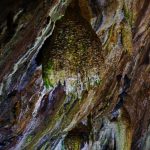
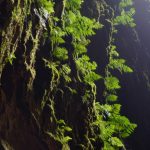 We then drove north to Biscoitos known for its lava pools. We returned to Angra via the western coastal road with a brief stop at the Duck Pool and Sao Mateus, a fishing village to look at a whale museum.
We then drove north to Biscoitos known for its lava pools. We returned to Angra via the western coastal road with a brief stop at the Duck Pool and Sao Mateus, a fishing village to look at a whale museum.
We ended our tour in a dairy factory where I bought local cheese, a bottle of green wine and yogurt drinks. I had a great day with a full stomach. I skipped dinner and had cheese and wine instead. I went to bed early.
February 22 Thursday: Leisure Day
My plan for today was to hike on my own in Monte Brasil in the morning and with a guide in another part of the island in the afternoon (25euro). By 9am, I was at the guard post of the fortress. As the first guided tour of the fortress would not start till 11am, I decided to hike first. I returned to Pico Cruzinhas as the weather was excellent and I could see all the mountain ranges of the island. Then I tried to take a short cut through the bushes to go to the Whale Lookout and Pico do Zimbreiro at the far end of the peninsula. I got lost and wasted sometime finding my way.
When I reached the Whale Lookout, I saw a man with a binocular. He said he had spotted two fin whales about ten miles away! It was after 11:30am when I was back to the guard post to fortress. The guard told me to return in the afternoon. Too bad!
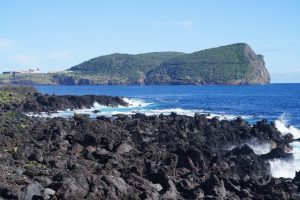 I had to cancel my afternoon hike as I felt some pains in my knee and hip in the morning. Instead, I went to Beira Mar in Sao Mateus for lunch. I spent 40 minutes waiting for Bus No 1 and arrived at the restaurant around 1:45pm. I had a glass of white wine, fish soup and two skewers of prawn and fish. Looking at the bill, I noted that I had not been charged for the wine. I asked for another bill. To my surprise, the man said, “It’s a gift for you!” I therefore only paid 14 euro for an excellent seafood lunch with wine.
I had to cancel my afternoon hike as I felt some pains in my knee and hip in the morning. Instead, I went to Beira Mar in Sao Mateus for lunch. I spent 40 minutes waiting for Bus No 1 and arrived at the restaurant around 1:45pm. I had a glass of white wine, fish soup and two skewers of prawn and fish. Looking at the bill, I noted that I had not been charged for the wine. I asked for another bill. To my surprise, the man said, “It’s a gift for you!” I therefore only paid 14 euro for an excellent seafood lunch with wine.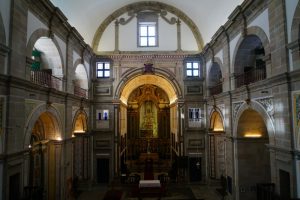
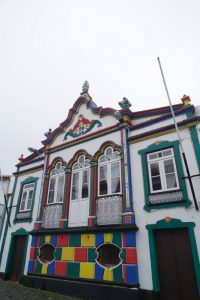 It was 2:30pm. I either had to wait for the 3:10pm bus or walk. I chose the latter and was back in the hostel at 3:30pm. After a short rest, I took another stroll in the old town to soak in the atmosphere. Around 5pm, I arrived at Igreja da Misericordia but noticed the door was still open. I paid 1,50 euro for the visit. There are many museums in Angra. But I have given most of them a miss. Strolling through the old town at my leisure and sensing the passage of time is already enough.
It was 2:30pm. I either had to wait for the 3:10pm bus or walk. I chose the latter and was back in the hostel at 3:30pm. After a short rest, I took another stroll in the old town to soak in the atmosphere. Around 5pm, I arrived at Igreja da Misericordia but noticed the door was still open. I paid 1,50 euro for the visit. There are many museums in Angra. But I have given most of them a miss. Strolling through the old town at my leisure and sensing the passage of time is already enough.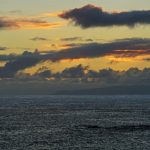
I walked back to the hostel and planned to go out to watch sunset after having a hot shower. By the time I opened the door, I was delighted to see deep orange and golden clouds across the sky. Fantastic! But the sun set within ten minutes. By the time I reached the sea front, the sun had gone. I spent a quiet evening packing up and finishing my wine and cheese.
February 23 Friday: Terceira – Pico by Air
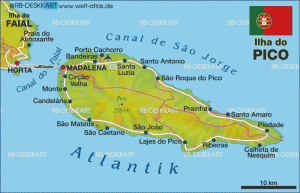 I had a taxi transfer (20 euro) at 9:45am and the plane took off around 11:15am. I landed about 20 minutes later in Pico. It was raining, cold and grey. The tourist office told me there are only two buses a day. The next one would be after 6pm. I was advised to take a taxi. A lady standing near the office offered me a lift. I fully appreciate her kindness. As a token of appreciation, I gave her 10 euro. She looks happy and I hope I have done something good for the local economy.
I had a taxi transfer (20 euro) at 9:45am and the plane took off around 11:15am. I landed about 20 minutes later in Pico. It was raining, cold and grey. The tourist office told me there are only two buses a day. The next one would be after 6pm. I was advised to take a taxi. A lady standing near the office offered me a lift. I fully appreciate her kindness. As a token of appreciation, I gave her 10 euro. She looks happy and I hope I have done something good for the local economy.
Pico measuring 46km long and 16km wide is the second largest island of the archipelago with an area of 447km2 and a population of about 15,000. It is known as the “Black Island” owing to its black volcanic earth. Wine culture dates back to the 15th century. Its vineyard divided into plots protected by walls built with basalt blocks has created unique landscape on the island. The landscape of the vineyard culture is a World Heritage Site. Today, the island’s economy is driven by tourism, shipbuilding and wine production. 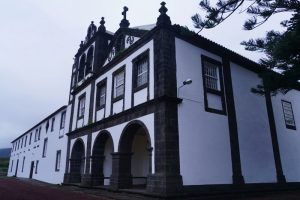
I have picked a YHA hostel in Sao Roque do Pico because it is housed in the Sao Pedro de Alcantara Convent (origin in 1658 and completion in 1726). The Baroque building was converted into a youth hostel in 2010 while the church remains in use and opens on Sunday.
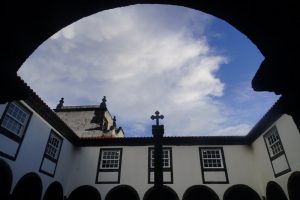 Though it was raining, I decided to walk to the town centre to have lunch. Only a bar restaurant by the harbour was opened. I was surprised to find the place fairly full. The barman told me that it was too late for the buffet lunch as most of the food had gone. He suggested me have burger or sandwich with chips. No way! I said I would be fine with whatever was still available. At the end, I had bean soup, grilled chicken, rice and vegetables. He charged me 7 instead of 9 euro. The locals are honest and friendly.
Though it was raining, I decided to walk to the town centre to have lunch. Only a bar restaurant by the harbour was opened. I was surprised to find the place fairly full. The barman told me that it was too late for the buffet lunch as most of the food had gone. He suggested me have burger or sandwich with chips. No way! I said I would be fine with whatever was still available. At the end, I had bean soup, grilled chicken, rice and vegetables. He charged me 7 instead of 9 euro. The locals are honest and friendly.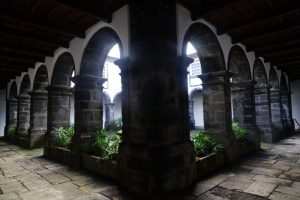
Pico, Faial and Sao Jorge are known as the Triangle with daily ferries between the islands. After looking at the bus and ferry schedules, I planned to spend a night in Sao Jorge on February 24 and Faial on February 25. I booked accommodation in both islands online. As the weather was bad, I stayed indoor spending the rest of the day writing my travel notes and uploading photos of India to my website. As I had to catch a bus to the ferry pier in Madalena around 7:15am the next day, I went to bed early. But I could not sleep as the wind was blowing hard. The windows seemed to be shaking.
February 24 Saturday: Pico – Faial by Ferry
I reached the ferry pier around 8am and saw the first ferry to Faial departing at 8:15am. The ferry to Sao Jorge was scheduled to leave at 10:15am. But at 9am, I was told that the ferry to Sao Jorge was cancelled owing to strong wind and big waves. The only place I could go now was Faial. The next ferry to Faial would depart at 11:30am. I was frustrated as I wasted the whole morning at the pier. But looking at the gale winds and towering waves, I could understand the rationale: safety is of paramount importance especially a ferry boat had grounded recently. The boat was still lying in the harbour. Anyway, it was not the first time I found myself stranded by foul weather!
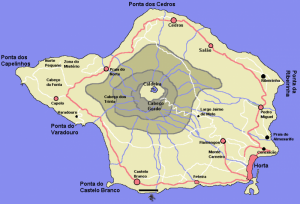 Faial (also known as the ‘Blue Island’ thanks to the large quantity of hydrangeas with blue flowers in the summer), has an area of 173km2 and a population of 15,000. Discovered in the first half the 15th century, it was not settled till 1460s with settlers mainly coming from the north Portugal. Later Flemish arrived in the place now known as Flamengos. The Capelinehos Volcano is probably the westernmost point of Europe. Horta is the main city on the island with an excellent sheltered harbour.
Faial (also known as the ‘Blue Island’ thanks to the large quantity of hydrangeas with blue flowers in the summer), has an area of 173km2 and a population of 15,000. Discovered in the first half the 15th century, it was not settled till 1460s with settlers mainly coming from the north Portugal. Later Flemish arrived in the place now known as Flamengos. The Capelinehos Volcano is probably the westernmost point of Europe. Horta is the main city on the island with an excellent sheltered harbour.
Faial is only 7km from Pico and there are four daily ferries between the two islands. The journey takes about 30 minutes. I walked from the pier to the Faial Mariana Apartments and the owner kindly allowed me to change my stay from February 25 to 24 (the booking was supposed to be non-changeable and non-refundable). The studio flat is neat and cosy. Instead of dining out, I decided to cook. I had fish, pasta and a glass of Pico wine for lunch.
After a healthy lunch, I went out with a blue sky and sunshine. I walked along the marina before heading to Monte da Guia, which affords excellent views of Horta city, the beach of Porto Pim, the coast till Ponta de Castelo Branco and Pico Island.
I followed a walking trail which starts at the sandy beach near Porto Pim. This is the only beach on the island with yellow sand. Then I walked past a few houses that have been turned into museums. I followed a flight of steep steps all the way to a chapel on the end of the walk. The chapel was closed. But I had fabulous views of the caldera bay below.
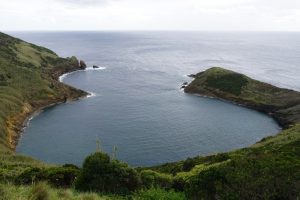
Instead of taking the same trail, I followed the paved road which is much longer. At 5pm, I was back in the marina and walked past the Peter Café Sport, an institution at the marina where seamen and sailors all over the world drop in for a drink. I love to have a drink and soak in the atmosphere. But it was too early: the bar was empty. I was told to return at 11pm when live music would start. Too late for me! As soon as I stepped into my studio, it started to rain heavily with a drastic drop in temperature. I was lucky!
I was fortunate in finding an island tour on Sunday (35euro pp). When I first met Carlo, the boss of a local agent, he said the tour required a minimum of two persons. He was hoping one more person would confirm after 6pm when he returned from Pico. Shortly after 6:30pm, Carlo informed me that the tour would begin at 9:30am.
In the evening, I found an interesting and cheaper way to return to Stockholm on April 7 to catch my flight to Hong Kong on April 8. Norwegian Air flies from Gatwick to Bergen with connecting flight to Stockholm for about 150euro. I have been to Bergen but do not mind visiting it again in spring. I immediately booked a flight departing London on April 5.
February 25 Sunday: Faial – Pico by Ferry
I had an excellent sleep of ten hours. It was pouring with rain till 9:30am. Then the sky suddenly cleared up. But the temperature dropped to round 5-10 degree. My guide cum driver was a nice lady from the island and the other passenger was Carlos from Lisbon who came here to inspect his dream sailing boat that he found online. He discovered the engine was not in good condition and the deal was cancelled. He joined a tour to Pico the day before and would tour around Faial today before returning to Lisbon on Monday.
Apparently, today was the coldest winter day in Faial. Snow and hail could still be seen on high ground. Our first stop was the Nossa Senhora da Conceicao, the patron saint of the island. The road to the famous caldera, a crater with is beautiful with views of Pico and the Flamengos valley.
By the time we reached the caldera measuring 400m deep and 2km in perimeter, it was freezing. I could see Cabeco Gordo, the highest point of the island at 1,043m, standing at the southern rim. Dark fog was rolling down from the rim and the crater floor looked blackish and evil! It was so cold and windy that I could not stand outside for more than five minutes! I felt colder here than in Longyearbyen in the Arctic!
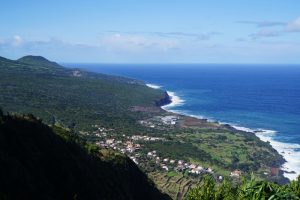 Once we began our descent through beautiful woodland, I felt being in a different world. We followed the main road counter-clockwise with many stops at viewpoints. I was overwhelmed by the awesome landscapes and scenery. I had good views of Sao Jorge and Graciosa. Mount Pico covered in snow was most beautiful.
Once we began our descent through beautiful woodland, I felt being in a different world. We followed the main road counter-clockwise with many stops at viewpoints. I was overwhelmed by the awesome landscapes and scenery. I had good views of Sao Jorge and Graciosa. Mount Pico covered in snow was most beautiful.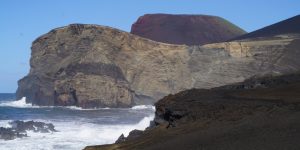
It was wonderful to see happy and healthy cows lying on the green pasture separated by volcanic rocks or camellia bushes and other trees. The colourful houses dotting around the island, look rustic but most picturesque. It is a paradise!
Half way through, we reached Praia do Norte offering full view of Cabeco do Fogo (Fire Mountain) which eruptions between 1672 and 1845 has created today’s Zone of Misterio and Faja. We saw a tiny top of a church which had been buried by the roadside.
The Capelo Volcanic Complex at the westernmost end of the island is the highlight of the trip. The last eruption occurring along Costa da Nau and Ponta dos Caplinhos, near the small parish of Capelinhos formed by volcanic eruption beginning on September 27, 1957. Eruptions continued till May 12, 1958 enlarging the island by 2.4km2 and extending the “Ponta dos Capelinhos’” into the western ocean. This most recent geomorphological feature composes of a linear series of scoria cones, resulting from basaltic volcanism of low explosivity. I could see some roofs of houses of the parish.
There are a few interesting things to do here. One can follow a trail to the volcano chimney and look at the caldera. There is also an interpretation centre in the lighthouse. I loved to walk but time did not permit.
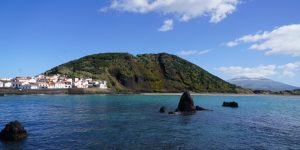 Our final stop was Ponta do Varadouro which used to have a hot spring before the eruption. Today, this posh area is dotted with summer houses.
Our final stop was Ponta do Varadouro which used to have a hot spring before the eruption. Today, this posh area is dotted with summer houses.
The scenic drive finished at 1:30pm. Our guide dropped us off at a local restaurant in town near the ferry pier. The Sunday buffet provided typical local dishes including boiled pork, beef and vegetables. We paid over 10 euro each for food and wine. Great value!
My ferry to Sao Jorge would leave at 4:45pm. When I was at the pier at 3:30pm, I was told that the ferry was cancelled owing to big waves. I was frustrated as I had already booked a hotel in Sao Jorge. What should I do? Stay in Faial or return to Pico? I decided to take the 5:15pm ferry to Pico. There is no bus in the afternoon on Sunday. I therefore had to take a taxi for 15 euro. Tonight, I met two German girls at the hostel: three of us had the convent to ourselves!



